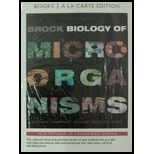
Concept explainers
Cellular membrane, nucleus, and cytoplasm are the three major components of a cell. Organelles are structures present within a cell and are specialized to perform a particular metabolic task essential for the survival of the cell. Eukaryotic cells consist of several organelles, including Golgi complex, mitochondria, endoplasmic reticulum, flagella and cilia, chloroplast, microfilaments and microtubules, and lysosomes. Similar to a nucleus, mitochondria are also surrounded by a double membrane system. Some microbial eukaryotes get killed by the presence of oxygen (O2). Such microbes do not contain mitochondria and some may possess structures referred to as hydrogenosomes.
Want to see the full answer?
Check out a sample textbook solution
Chapter 2 Solutions
Brock Biology of Microorganisms, Books a la Carte Plus Mastering Microbiology with eText -- Access Card Package (14th Edition)
- Q7. Which phrase best describes the chemical conditions inside the mitochondrial matrix? A. low pH and high pyruvate concentration B. high pH and high pyruvate concentration C. high pH and low pyruvate concentration D. low pH and low pyruvate concentrationarrow_forwardQ4Describe each component in glycolysis metabolic pathways involving the degradation of glucose.arrow_forwardQ16. Electron flow along an electron transport chain is a spontaneous process from molecules that are strong reducing agents to molecules that are stronger oxidizing agents. Given your knowledge of photosynthetic electron transport, which one of the following molecules is the strongest reducing agent (most easily oxidized)? A. P680 B. H2O C. P700* D. NADPHarrow_forward
- Q2. Assess the role of redox electron transfer in the formation of an electrochemical proton gradient (the proton motive force), as follows:a) Provide a critical evaluation of how the molecular structure of each respiratory complex contributes to their proton pumping and/or redox catalytic activities.arrow_forwardPredict possible consequences if carbon emissions from fossil fuels continue to rise.arrow_forwardNeed hhelp Please answer both a.What are the differences in electron acceptor and electron donors used by Escherichia coli (during aerobic cell respiration) and Acidithiobacillus thioparus (a sulfur chemolithotroph with the capacity for aerobic cell respiration)? b.What gives bacterial cell walls their structural integrity and why is that important.arrow_forward
- 13. Describe the differences between photosynthesis and cellular respiration in terms of redox chemistry.arrow_forwardQ19. In photosynthetic electron transport a proton gradient is established across the thylakoid membrane. Which of the following protein complexes does not contribute to establishing this proton gradient? A. Plastoquinone B. NADP+ reductase C. Oxygen evolving complex D. ATP synthasearrow_forwardQ26. Why doesn't a bag of sugar (glucose) readily break down into CO2 and H2O? A. Glucose has less free energy than CO2 B. The oxidation of glucose into CO2 is endergonic C. Glucose breakdown requires O2 as a co-substrate. D. Too few molecules gain the energy required to get to the transition state.arrow_forward
- Q40. Both Photosynthesis and respiration rely on electron transport. Although there are many differences, what do these electron transport chains have in common? In both, the electron donor (water in the case of photosynthesis, NADH in the case of respiration) is a strong reducing agent In both, the proteins which shuttle the electrons (Plastoquinone in photosynthesis, Ubiquinone in the case of respiration) are oxidized and reduced In both, electrons move spontaneously from high to low redox potential. In both, chemiosmosis results in the production of ATP A. 1,2 and 3 B. 1 and 3 C. 2 and 4 D. 4 only E. All of 1, 2, 3 and 4 are correctarrow_forwardQNo3: How plants fix atmospheric nitrogen? Explain the role of microbes in plant growth?arrow_forwardQ1: Why is photosynthesis called “primary production”? Q2: How does animal life depend on photosynthesis? Q3: Explain how photosynthesis and cellular respiration are “complementary” processes.arrow_forward
 Biology (MindTap Course List)BiologyISBN:9781337392938Author:Eldra Solomon, Charles Martin, Diana W. Martin, Linda R. BergPublisher:Cengage Learning
Biology (MindTap Course List)BiologyISBN:9781337392938Author:Eldra Solomon, Charles Martin, Diana W. Martin, Linda R. BergPublisher:Cengage Learning Biology 2eBiologyISBN:9781947172517Author:Matthew Douglas, Jung Choi, Mary Ann ClarkPublisher:OpenStax
Biology 2eBiologyISBN:9781947172517Author:Matthew Douglas, Jung Choi, Mary Ann ClarkPublisher:OpenStax

